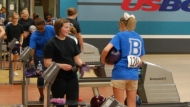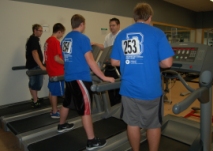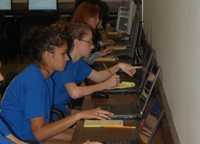Combine tests potential collegiate bowlers
August 10, 2012

ARLINGTON, Texas – More than 100 student-athletes had the opportunity for their skills to be evaluated and to meet with college coaches during the four-day Bowling Combine for College Prospects, which wrapped up Friday at the International Training and Research Center in Arlington.
The 48 girls and 60 boys who participated in this year’s Bowling Combine were run through a series of tests at the ITRC, the official training center of Team USA. The Team USA coaching staff evaluated the bowlers using state-of-the-art ball motion technology, video analysis and more.
More than 20 college coaches were on hand to watch the participants go through the drills and talk with potential prospects to see if the student-athletes might fit their programs.
Kristina Frahm, who became head coach at the University of Maryland Eastern Shore last season and led her team to the NCAA Women’s Bowling title, is recruiting for the first time. She said events such as the Bowling Combine and the North Pointe Junior Gold Championships allow her the opportunity to see young bowlers committed to the sport.
“It shows who has the love for the game, and that’s a big key to recruiting – who is willing to go out for these two long days of bowling,” Frahm said. “Here, they do both the athletic side as well as the bowling side, spare percentages and rotation and tilt … all of that comes into play when you are looking for good bowlers.”
The student-athletes, most starting their junior or senior years of high school, went through sport-specific tests that included spare shooting, release and speed ranges and shot repeatability. Players rotated through five stations during spare shooting and had the chance to throw at least 15 shots to convert each spare as many times as possible.
“It is a very good opportunity for us,” said Rebecca Gomez, one of three participants from Costa Rica. “It was a great experience. They really put us to work. We had the chance to work and train like the big teams do. It was a great opportunity to test ourselves and for us to show what the bowling level of Costa Rica is.”
 Part of the testing process included time in the gym, where participants underwent a series of tests to determine their overall athleticism. Among the tests performed were the vertical jump, balance test, grip strength and a functional movement screen. They also took the “IT Factor” test that evaluates their Bowling IQ, common problem-solving skills and provides a personality profile.
Part of the testing process included time in the gym, where participants underwent a series of tests to determine their overall athleticism. Among the tests performed were the vertical jump, balance test, grip strength and a functional movement screen. They also took the “IT Factor” test that evaluates their Bowling IQ, common problem-solving skills and provides a personality profile.
“I decided I want to pursue bowling after high school and through college, so I thought this would be good to attend,” said David Whitson of Carlisle, Ky., who will be a high school senior this fall. “I didn’t really understand that bowling is so high tech. Overall, this has been really good, although I wasn’t really ready for a test.”
Each athlete received a ranking called the Performance Evaluation Test (P.E.T.) score at the end of the Bowling Combine. The score is an objective view of their overall abilities in key areas necessary for success and can be compared against the bowlers at this, previous or future combines. Each bowler also received a Recruiting Kit that has video shots, bowler variables measured and a detailed report of personal data collected during the combine.
 The Bowling Combine was developed to allow young bowlers to be evaluated using objective standards and to give college coaches a chance to analyze the potential fit of the student-athletes in their programs. Team USA assistant coach Bryan O’Keefe is program director for the Combine and the ITRC staff of Team USA head coach Rod Ross, Team USA assistant head coach Kim Terrell-Kearney and USBC Sports Performance Specialist Nick Bohanan oversaw the testing.
The Bowling Combine was developed to allow young bowlers to be evaluated using objective standards and to give college coaches a chance to analyze the potential fit of the student-athletes in their programs. Team USA assistant coach Bryan O’Keefe is program director for the Combine and the ITRC staff of Team USA head coach Rod Ross, Team USA assistant head coach Kim Terrell-Kearney and USBC Sports Performance Specialist Nick Bohanan oversaw the testing.
Gordon Vadakin, head coach of Wichita State, said he had multiple reasons to attend the Bowling Combine along with assistant coach Mark Lewis.
“It’s always good to come to the ITRC to see what is going on with the technology; that’s always a plus,” Vadakin said. “It’s beneficial to see what they are working on, and how they are evaluating the kids. And we are here for recruiting; that’s probably the primary thing but there are other goals that are being accomplished. But we’re trying to see if there is someone who might be able to fill a hole a year from now or two years from now.”
Go to BOWL.com/Combine for complete information about the Bowling Combine.
The 48 girls and 60 boys who participated in this year’s Bowling Combine were run through a series of tests at the ITRC, the official training center of Team USA. The Team USA coaching staff evaluated the bowlers using state-of-the-art ball motion technology, video analysis and more.
More than 20 college coaches were on hand to watch the participants go through the drills and talk with potential prospects to see if the student-athletes might fit their programs.
Kristina Frahm, who became head coach at the University of Maryland Eastern Shore last season and led her team to the NCAA Women’s Bowling title, is recruiting for the first time. She said events such as the Bowling Combine and the North Pointe Junior Gold Championships allow her the opportunity to see young bowlers committed to the sport.
“It shows who has the love for the game, and that’s a big key to recruiting – who is willing to go out for these two long days of bowling,” Frahm said. “Here, they do both the athletic side as well as the bowling side, spare percentages and rotation and tilt … all of that comes into play when you are looking for good bowlers.”
The student-athletes, most starting their junior or senior years of high school, went through sport-specific tests that included spare shooting, release and speed ranges and shot repeatability. Players rotated through five stations during spare shooting and had the chance to throw at least 15 shots to convert each spare as many times as possible.
“It is a very good opportunity for us,” said Rebecca Gomez, one of three participants from Costa Rica. “It was a great experience. They really put us to work. We had the chance to work and train like the big teams do. It was a great opportunity to test ourselves and for us to show what the bowling level of Costa Rica is.”
 Part of the testing process included time in the gym, where participants underwent a series of tests to determine their overall athleticism. Among the tests performed were the vertical jump, balance test, grip strength and a functional movement screen. They also took the “IT Factor” test that evaluates their Bowling IQ, common problem-solving skills and provides a personality profile.
Part of the testing process included time in the gym, where participants underwent a series of tests to determine their overall athleticism. Among the tests performed were the vertical jump, balance test, grip strength and a functional movement screen. They also took the “IT Factor” test that evaluates their Bowling IQ, common problem-solving skills and provides a personality profile. “I decided I want to pursue bowling after high school and through college, so I thought this would be good to attend,” said David Whitson of Carlisle, Ky., who will be a high school senior this fall. “I didn’t really understand that bowling is so high tech. Overall, this has been really good, although I wasn’t really ready for a test.”
Each athlete received a ranking called the Performance Evaluation Test (P.E.T.) score at the end of the Bowling Combine. The score is an objective view of their overall abilities in key areas necessary for success and can be compared against the bowlers at this, previous or future combines. Each bowler also received a Recruiting Kit that has video shots, bowler variables measured and a detailed report of personal data collected during the combine.
 The Bowling Combine was developed to allow young bowlers to be evaluated using objective standards and to give college coaches a chance to analyze the potential fit of the student-athletes in their programs. Team USA assistant coach Bryan O’Keefe is program director for the Combine and the ITRC staff of Team USA head coach Rod Ross, Team USA assistant head coach Kim Terrell-Kearney and USBC Sports Performance Specialist Nick Bohanan oversaw the testing.
The Bowling Combine was developed to allow young bowlers to be evaluated using objective standards and to give college coaches a chance to analyze the potential fit of the student-athletes in their programs. Team USA assistant coach Bryan O’Keefe is program director for the Combine and the ITRC staff of Team USA head coach Rod Ross, Team USA assistant head coach Kim Terrell-Kearney and USBC Sports Performance Specialist Nick Bohanan oversaw the testing.Gordon Vadakin, head coach of Wichita State, said he had multiple reasons to attend the Bowling Combine along with assistant coach Mark Lewis.
“It’s always good to come to the ITRC to see what is going on with the technology; that’s always a plus,” Vadakin said. “It’s beneficial to see what they are working on, and how they are evaluating the kids. And we are here for recruiting; that’s probably the primary thing but there are other goals that are being accomplished. But we’re trying to see if there is someone who might be able to fill a hole a year from now or two years from now.”
Go to BOWL.com/Combine for complete information about the Bowling Combine.





